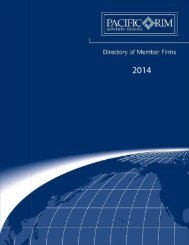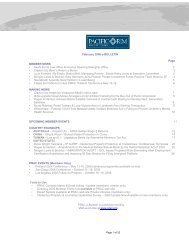• an ADI’s default <strong>in</strong> respect <strong>of</strong> a cus<strong>to</strong>mer’s deposit may result<strong>in</strong> <strong>the</strong> cus<strong>to</strong>mer default<strong>in</strong>g on its mortgage loan. In thissituation, <strong>the</strong> mortgage loan and <strong>the</strong> deposit could beregarded as so closely connected that it would be unjust not<strong>to</strong> allow <strong>the</strong> cus<strong>to</strong>mer <strong>to</strong> set <strong>of</strong>f <strong>the</strong> deposit aga<strong>in</strong>st <strong>the</strong>mortgage loan.Generally speak<strong>in</strong>g, <strong>the</strong> more closely <strong>the</strong> contracts under which<strong>the</strong> claims arise are related, <strong>the</strong> more likely it will be that anequity will arise <strong>to</strong> allow a set-<strong>of</strong>f.8.4 Contractual set-<strong>of</strong>fTwo parties can enter <strong>in</strong><strong>to</strong> an agreement <strong>to</strong> set <strong>of</strong>f <strong>the</strong>irrespective liabilities <strong>to</strong> each o<strong>the</strong>r so that <strong>the</strong>re is only, asbetween <strong>the</strong>m, a s<strong>in</strong>gle liability for <strong>the</strong> balance. Contractual se<strong>to</strong>fftakes effect accord<strong>in</strong>g <strong>to</strong> its terms and is enforceable untilone <strong>of</strong> <strong>the</strong> parties <strong>to</strong> <strong>the</strong> agreement becomes bankrupt or<strong>in</strong>solvent.In <strong>the</strong> context <strong>of</strong> <strong>the</strong> relationship between an ADI and one <strong>of</strong>its cus<strong>to</strong>mers, contractual set-<strong>of</strong>f will only apply if <strong>the</strong>re is anagreement <strong>to</strong> this effect <strong>in</strong> <strong>the</strong> documents regulat<strong>in</strong>g <strong>the</strong> rightsbetween <strong>the</strong>m. It is usual that <strong>the</strong> documentation <strong>in</strong> relation <strong>to</strong> amortgage loan will provide <strong>the</strong> ADI with a right <strong>to</strong> comb<strong>in</strong>e <strong>the</strong>accounts <strong>of</strong> <strong>the</strong> cus<strong>to</strong>mer. The correct classification <strong>of</strong> such acomb<strong>in</strong>ation <strong>of</strong> accounts clause is that it is a form <strong>of</strong> contractualset-<strong>of</strong>f.8.5 Insolvency set-<strong>of</strong>fInsolvency set-<strong>of</strong>f arises where one <strong>of</strong> <strong>the</strong> claimants is <strong>in</strong>solven<strong>to</strong>r bankrupt. Insolvency set-<strong>of</strong>f is governed by statute (section 86<strong>of</strong> <strong>the</strong> Bankruptcy Act 1966 for <strong>in</strong>dividuals and section 553C <strong>of</strong><strong>the</strong> Corporations Act for companies).The two sections are identical and provide that where <strong>the</strong>re havebeen mutual credits, mutual debts or o<strong>the</strong>r mutual deal<strong>in</strong>gs (seesection 8.6) between <strong>the</strong> bankrupt (or <strong>in</strong>solvent) person and aperson claim<strong>in</strong>g a debt <strong>in</strong> <strong>the</strong> bankruptcy (or <strong>in</strong>solvency):“(a) an account will be taken <strong>of</strong> what is due from one party <strong>to</strong><strong>the</strong> o<strong>the</strong>r <strong>in</strong> respect <strong>of</strong> those mutual deal<strong>in</strong>gs;(b) <strong>the</strong> sum due from one party must be set <strong>of</strong>f aga<strong>in</strong>st any sumdue from <strong>the</strong> o<strong>the</strong>r party; and(c) only <strong>the</strong> balance <strong>of</strong> <strong>the</strong> account may be claimed or ispayable.”Insolvency set-<strong>of</strong>f, when it applies, is manda<strong>to</strong>ry and applies <strong>to</strong><strong>the</strong> exclusion <strong>of</strong> statu<strong>to</strong>ry, equitable and contractual set-<strong>of</strong>f.Unlike o<strong>the</strong>r forms <strong>of</strong> set-<strong>of</strong>f it cannot be excluded by agreementbetween <strong>the</strong> parties (see section 8.7).8.6 MutualityFor statu<strong>to</strong>ry set-<strong>of</strong>f or <strong>in</strong>solvency set-<strong>of</strong>f <strong>to</strong> be permitted <strong>the</strong>remust be mutuality. The general pr<strong>in</strong>ciple underly<strong>in</strong>g mutuality isthat <strong>the</strong> claim <strong>of</strong> one person should not, without agreement, beused <strong>to</strong> satisfy <strong>the</strong> liability <strong>of</strong> ano<strong>the</strong>r ie. “one man’s money shallnot be applied <strong>to</strong> pay ano<strong>the</strong>r man’s debt” (Jones v Mossop(1844) 3 Hare 568).For <strong>the</strong>re <strong>to</strong> be mutuality, each claimant must be <strong>the</strong> beneficialowner <strong>of</strong> <strong>the</strong> claim owed <strong>to</strong> it. Generally, set-<strong>of</strong>f will not beavailable if <strong>the</strong> claims are legally mutual, but not equitablymutual. For example, a debt due <strong>to</strong> a party <strong>in</strong> its own right cannotbe set <strong>of</strong>f aga<strong>in</strong>st a sum owed by <strong>the</strong> party <strong>in</strong> its capacity astrustee.In <strong>the</strong> securitisation <strong>of</strong> loans outl<strong>in</strong>ed above, and prior <strong>to</strong>perfection <strong>of</strong> title, <strong>the</strong> ADI is <strong>the</strong> legal owner <strong>of</strong> <strong>the</strong> sold loans,but <strong>the</strong> special purpose vehicle is <strong>the</strong> owner <strong>in</strong> equity. Afterperfection <strong>of</strong> title, <strong>the</strong> ADI will be nei<strong>the</strong>r <strong>the</strong> legal nor equitableowner <strong>of</strong> <strong>the</strong> sold loans.The mutuality pr<strong>in</strong>ciple <strong>the</strong>refore, on its face, seems <strong>to</strong> preventstatu<strong>to</strong>ry or <strong>in</strong>solvency set-<strong>of</strong>f by <strong>the</strong> cus<strong>to</strong>mer as a result <strong>of</strong> <strong>the</strong>change <strong>in</strong> equitable ownership <strong>of</strong> <strong>the</strong> loan. Generally <strong>the</strong> time fordeterm<strong>in</strong><strong>in</strong>g mutuality is when <strong>the</strong> set-<strong>of</strong>f is be<strong>in</strong>g asserted (or,for <strong>in</strong>solvency set-<strong>of</strong>f, as at <strong>the</strong> commencement <strong>of</strong> <strong>the</strong><strong>in</strong>solvency). The most important variation from this pr<strong>in</strong>ciple is <strong>in</strong><strong>the</strong> context <strong>of</strong> <strong>the</strong> assignment <strong>of</strong> a debt (which is relevant here).Where <strong>the</strong>re is an assignment <strong>of</strong> a primary debt, <strong>the</strong> assigneetakes subject <strong>to</strong> <strong>the</strong> equities. This means, <strong>in</strong> <strong>the</strong> situation underdiscussion, that <strong>the</strong> special purpose vehicle takes a sold loansubject <strong>to</strong> <strong>the</strong> right <strong>of</strong> <strong>the</strong> cus<strong>to</strong>mer <strong>to</strong> assert aga<strong>in</strong>st <strong>the</strong> specialpurpose vehicle <strong>the</strong> same set-<strong>of</strong>f rights that it could haveasserted aga<strong>in</strong>st <strong>the</strong> ADI. However, once <strong>the</strong> cus<strong>to</strong>mer receivesnotice <strong>of</strong> <strong>the</strong> assignment, this crystallises <strong>the</strong> equities and <strong>the</strong>cus<strong>to</strong>mer cannot <strong>the</strong>reafter set up as aga<strong>in</strong>st <strong>the</strong> special purposevehicle any new and <strong>in</strong>dependent equities which subsequentlyarise (subject <strong>to</strong> some exceptions which are not relevant here). Inpractice, this means that once <strong>the</strong> cus<strong>to</strong>mer is advised <strong>of</strong> <strong>the</strong>assignment <strong>of</strong> its loan it will not be able <strong>to</strong> claim a set-<strong>of</strong>f for anynew deposits that it makes with <strong>the</strong> ADI (but will reta<strong>in</strong> its rights<strong>in</strong> relation <strong>to</strong> any exist<strong>in</strong>g deposits).49
50However, this result and <strong>the</strong> pr<strong>in</strong>ciple that an assignee takessubject <strong>to</strong> <strong>the</strong> equities, does not apply if <strong>the</strong> cus<strong>to</strong>mer agreeso<strong>the</strong>rwise. Often, loan documentation explicitly states that <strong>the</strong>ADI may assign <strong>the</strong> loan free <strong>of</strong> all equities. A provision <strong>of</strong> thistype is effective subject <strong>to</strong> <strong>the</strong> matters discussed <strong>in</strong> section 8.7.The absence <strong>of</strong> mutuality is relevant only for statu<strong>to</strong>ry and<strong>in</strong>solvency set <strong>of</strong>f. Strictly speak<strong>in</strong>g, mutuality is not an essential<strong>in</strong>gredient for contractual set-<strong>of</strong>f. There is no pr<strong>in</strong>ciple <strong>of</strong> lawprevent<strong>in</strong>g A, B and C agree<strong>in</strong>g that A’s liability <strong>to</strong> B can be se<strong>to</strong>ff aga<strong>in</strong>st B’s liability <strong>to</strong> C.Mutuality also is not strictly essential for equitable set-<strong>of</strong>f (but <strong>in</strong>most circumstances mutuality will effectively be required as itwill usually be <strong>in</strong>equitable <strong>to</strong> apply one person’s rights aga<strong>in</strong>stano<strong>the</strong>r’s debts).8.7 Contractual exclusion <strong>of</strong> set-<strong>of</strong>fBoth statu<strong>to</strong>ry set-<strong>of</strong>f and equitable set-<strong>of</strong>f can be excluded byan express contractual provision <strong>to</strong> this effect.In some early English cases it was held that statu<strong>to</strong>ry set-<strong>of</strong>fcould not be excluded by agreement. These cases are no longergood law. This was confirmed by <strong>the</strong> English Court <strong>of</strong> Appeal <strong>in</strong>Coca-Cola F<strong>in</strong>ancial Corporation v F<strong>in</strong>stat International Ltd [1996]3 WLR 849 (and, effectively, by <strong>the</strong> House <strong>of</strong> Lords <strong>in</strong> refus<strong>in</strong>gleave <strong>to</strong> appeal <strong>the</strong> decision <strong>in</strong> this case). There have also been anumber <strong>of</strong> <strong>Australia</strong>n cases that confirm that statu<strong>to</strong>ry set-<strong>of</strong>fmay be excluded by agreement.Contractual set-<strong>of</strong>f is purely a creature <strong>of</strong> contract and will apply<strong>to</strong> <strong>the</strong> extent agreed.In contrast <strong>to</strong> o<strong>the</strong>r forms <strong>of</strong> set-<strong>of</strong>f, <strong>in</strong>solvency set-<strong>of</strong>f ismanda<strong>to</strong>ry and may not be excluded by contract. Fur<strong>the</strong>r, <strong>in</strong> <strong>the</strong>case <strong>of</strong> loans governed by <strong>the</strong> Consumer Credit Code (which<strong>in</strong>cludes all owner occupied mortgage loans orig<strong>in</strong>ated after 1November 1996), <strong>the</strong> stated pr<strong>in</strong>ciples are subject <strong>to</strong> <strong>the</strong>application <strong>of</strong> section 166 <strong>of</strong> <strong>the</strong> Code. Section 166(2) providesthat a “deb<strong>to</strong>r, mortgagor or guaran<strong>to</strong>r has and may exercise <strong>the</strong>same rights <strong>in</strong> respect <strong>of</strong> [a] credit contract, mortgage orguarantee aga<strong>in</strong>st <strong>the</strong> assignee [<strong>of</strong> <strong>the</strong> credit contract, mortgageor guarantee] as <strong>the</strong> deb<strong>to</strong>r, mortgagor or guaran<strong>to</strong>r has aga<strong>in</strong>st<strong>the</strong> credit provider.”The operation <strong>of</strong> <strong>the</strong> Code cannot be excluded by contract.It is not clear that section 166(2) applies <strong>to</strong> rights <strong>of</strong> set-<strong>of</strong>f.Never<strong>the</strong>less section 166 throws doubt upon <strong>the</strong> operation <strong>of</strong>provisions <strong>in</strong> loans governed by <strong>the</strong> Code that allow <strong>the</strong> loan <strong>to</strong>be assigned by <strong>the</strong> ADI free <strong>of</strong> any equities. The section does nothave any impact on clauses <strong>in</strong> a loan that provide for payments <strong>to</strong>be made by a cus<strong>to</strong>mer free <strong>of</strong> set-<strong>of</strong>f, deduction or counterclaimas such clauses apply equally <strong>to</strong> <strong>the</strong> orig<strong>in</strong>al credit provider andan assignee.8.8 Cus<strong>to</strong>mer’s ability <strong>to</strong> set-<strong>of</strong>f aga<strong>in</strong>st an <strong>in</strong>solvent ADIFor practical purposes a cus<strong>to</strong>mer’s rights <strong>to</strong> set-<strong>of</strong>f will only berelevant upon <strong>the</strong> <strong>in</strong>solvency <strong>of</strong> <strong>the</strong> ADI. If a cus<strong>to</strong>mer exercises aright <strong>of</strong> set-<strong>of</strong>f prior <strong>to</strong> <strong>the</strong> ADI’s <strong>in</strong>solvency, <strong>the</strong> agreementbetween <strong>the</strong> special purpose vehicle and <strong>the</strong> ADI will usuallyprovide that <strong>the</strong> ADI must compensate <strong>the</strong> special purposevehicle for, or make payments <strong>to</strong> <strong>the</strong> special purpose vehicle clear<strong>of</strong>, amounts set-<strong>of</strong>f by <strong>the</strong> cus<strong>to</strong>mer.If <strong>the</strong> ADI becomes <strong>in</strong>solvent, <strong>the</strong> special purpose vehicle will<strong>the</strong>n immediately perfect its title <strong>to</strong> <strong>the</strong> assigned loans. In <strong>the</strong>secircumstances <strong>the</strong> cus<strong>to</strong>mer will be endeavour<strong>in</strong>g <strong>to</strong> set-<strong>of</strong>f <strong>in</strong>respect <strong>of</strong> its obligations <strong>to</strong> <strong>the</strong> special purpose vehicle under itsADI loan and <strong>the</strong> <strong>in</strong>solvent ADI’s obligations <strong>to</strong> it <strong>in</strong> respect <strong>of</strong>deposit accounts. Apply<strong>in</strong>g <strong>the</strong> rules <strong>of</strong> set-<strong>of</strong>f discussed aboveleads <strong>to</strong> <strong>the</strong> follow<strong>in</strong>g conclusions:Statu<strong>to</strong>ry set-<strong>of</strong>fWhen <strong>the</strong> cus<strong>to</strong>mer’s loan is assigned <strong>in</strong> equity <strong>to</strong> a specialpurpose vehicle <strong>the</strong> cus<strong>to</strong>mer will lose any rights <strong>of</strong> statu<strong>to</strong>ry se<strong>to</strong>ffthat it may have <strong>in</strong> relation <strong>to</strong> <strong>the</strong> loan and a deposit accoun<strong>the</strong>ld with <strong>the</strong> ADI. This is because <strong>the</strong>re will no longer be anymutuality between <strong>the</strong> beneficial <strong>in</strong>terests <strong>in</strong> respect <strong>of</strong> <strong>the</strong> ADI’srights under <strong>the</strong> loan and obligations under <strong>the</strong> deposit account.Also, a cus<strong>to</strong>mer will be bound by any provision <strong>in</strong> <strong>the</strong> loan ordeposit account documentation that excludes <strong>the</strong> cus<strong>to</strong>mer’srights <strong>of</strong> statu<strong>to</strong>ry set-<strong>of</strong>f or (subject <strong>to</strong> <strong>the</strong> possible application<strong>of</strong> section 166 <strong>of</strong> <strong>the</strong> Consumer Credit Code) allows <strong>the</strong> ADI <strong>to</strong>assign <strong>the</strong> mortgage loan free <strong>of</strong> such rights.Equitable set-<strong>of</strong>fIn certa<strong>in</strong> circumstances, a cus<strong>to</strong>mer may have a right <strong>of</strong>equitable set-<strong>of</strong>f aga<strong>in</strong>st its loan <strong>in</strong> respect <strong>of</strong> a deposit accoun<strong>the</strong>ld by <strong>the</strong> cus<strong>to</strong>mer with <strong>the</strong> ADI. This may be <strong>the</strong> case notwithstand<strong>in</strong>g <strong>the</strong> lack <strong>of</strong> mutuality <strong>of</strong> beneficial or legal <strong>in</strong>terestswith respect <strong>to</strong> <strong>the</strong> loan and that deposit account. However, <strong>the</strong>cus<strong>to</strong>mer will not have any right <strong>of</strong> set-<strong>of</strong>f <strong>in</strong> respect <strong>of</strong> depositsmade after <strong>the</strong> cus<strong>to</strong>mer becomes aware <strong>of</strong> <strong>the</strong> assignment <strong>of</strong> <strong>the</strong>loan. Fur<strong>the</strong>r, this result is subject <strong>to</strong> any provision <strong>in</strong> <strong>the</strong> mortgageloan or deposit account documentation that excludes <strong>the</strong>cus<strong>to</strong>mer’s rights <strong>of</strong> equitable set-<strong>of</strong>f or (subject <strong>to</strong> <strong>the</strong> possibleapplication <strong>of</strong> section 166 <strong>of</strong> <strong>the</strong> Consumer Credit Code) allows<strong>the</strong> ADI <strong>to</strong> assign <strong>the</strong> mortgage loan free <strong>of</strong> such rights.






